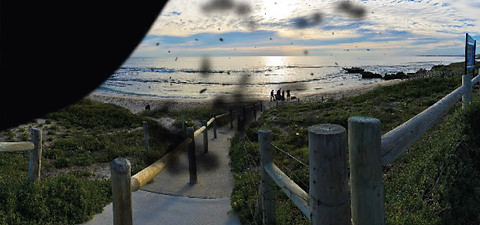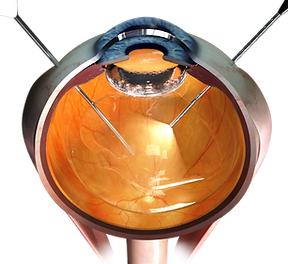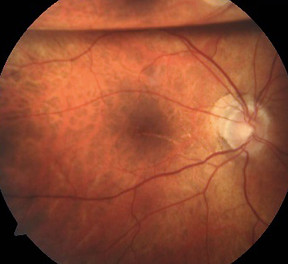Retinal Detachment
Eye Conditions
Cataract
CSCR
Diabetic Retinopathy
Epiretinal Membrane
Flashes and Floaters
Glaucoma
Macular Degeneration
Macular Hole
Retinal Detachment
Retinal Vein Occlusion
Uveitis
Vitreomacular Traction
Investigations
Procedures
Retinal detachment is when the retina comes off the inside wall of the eye. Without treatment, retinal detachment will almost certainly lead to blindness. This is usually a medical emergency that requires a prompt surgery.


Detached retina

Symptoms
-
Flashes and floaters
-
Dark shadows in corner of vision
-
Blurred vision
-
Distorted image
Floaters obscuring the centre and dark shadow in the corner of vision
Treatment of Retinal Detachment
This technique is more commonly used and involves removing the vitreous using very fine instruments through wounds in the sclera (white of the eye). The retinal tears are identified and the fluid under the retina is sucked out. A gas bubble is injected in the eye cavity to prevent fluid getting under the retina again. The gas bubble dissipates in 2 to 4 weeks and you may be asked to keep posturing (e.g., look down) for several days. Air travel is absolutely prohibited until gas is completely gone.
This is an older technique but still is the most effective option for many types of retinal detachment. A piece of silicone rubber is sewn onto the sclera to push the wall of the eye inwards, bringing it closer to the detached retina. The buckle is permanently left in place. Buckle surgery is less comfortable than vitrectomy, and may lead to double vision.


Gas bubble

Warning: Clinical surgical footage
Repair of retinal detachment by vitrectomy
What is retinal detachment?
The retina is the thin light-sensitive layer that lines the inside of the eye. Retinal detachment is the separation of the retina from the wall of the eye. The retina cannot function when detached, and will perish and become scarred. With a few exceptions, retinal detachment is universally blinding if left untreated. Because retinal detachment starts in the periphery and expands towards the macula, patients may notice a dark shadow in the corner of their vision, which extends towards the centre. The images become distorted and vision blurs.
Who are affected?
Retinal detachment usually occurs in people older than 50 years of age, but it can occur in younger people. It occurs spontaenously in most cases, but it can also be caused by eye surgery (e.g., cataract extraction) or a trauma to the eye. People who are short-sighted, or have family history of retinal detachment, are at higher risk.
What causes retinal detachment?
The most common cause of retinal detachment is a retinal tear that develops during Posterior Vitreous detachment. Fluid inside the eye cavity can seep under the retina through the tear, causing the retina to become detached. Less frequently, retinal detachment can be caused from scarring of the vitreous and retina (e.g., severe diabetic retinopathy), or from leakage of fluid from under the retina (e.g., tumours).
How is retinal detachment diagnosed?
Retinal detachment is readily diagnosed using an examination microscope. OCT scan may be performed to determine whether the macula has been detached. If there has been a severe bleeding, ultrasound examination may be required to diagnose the retinal detachment, as the retina will be obscured by blood.
When should retinal detachment be treated?
Retinal detachment not involving the macula requires an emergency surgery. Successful repair is likely to restore the vision almost to the normal level. However, if the macula has been detached, some loss of vision will be expected. The surgery for such cases can be postponed to a more convenient time within the week. Long standing retinal detachments do not require an urgent surgery.
How is retinal detachment treated?
Retinal detachment is treated by vitrectomy or scleral buckle. Modern vitrectomy technique uses tiny wounds and do not require sutures. Three small wounds are made on the white part of the eye, through which an infusion tube, light source and vitrectomy cutter are inserted. After the removal of the vitreous gel, the retina is flattened and the retinal tears are sealed with laser or cryotherapy. A bubble of gas or silicone oil is injected into the eye cavity to keep the retina flattened. The head may need to be kept in a certain position for one week to keep the gas bubble on the tear and the gas dissipates over a number of weeks. Silicone oil needs to be removed, requiring a second surgery, but head positioning is not necessary when the oil is used.
Scleral buckling is performed by sewing a piece of silicone on to the surface of the white of the eye (sclera) and under the muscles of eye movement. This supports the retina from the outside, allowing it to flatten. The retinal tears are sealed with laser or cryotherapy. Certain retinal detachments are better suited for vitrectomy, while others require scleral buckle. The decision can only be made by the surgeon after a care examination of the eye.
What are the risks and benefits of surgery for retinal detachment?
Even though retinal detachment surgery is not an elective procedure, you should be aware of possible complications.
-
In around 10 to 15 % of patients, the retina will detach again, requiring a further surgery. Failure to reattach the retina will lead to blindness.
-
Vitrectomy with gas or silicone oil bubble causes cataract to develop, which may require surgery later.
-
Scleral buckling requires extensive incisions of conjunctiva (a thin, loose skin covering the white of the eye) and can be painful initially. It can also cause changes in focus and double vision.
-
As for all surgeries, severe bleeding and infection can develop, but these are rare.